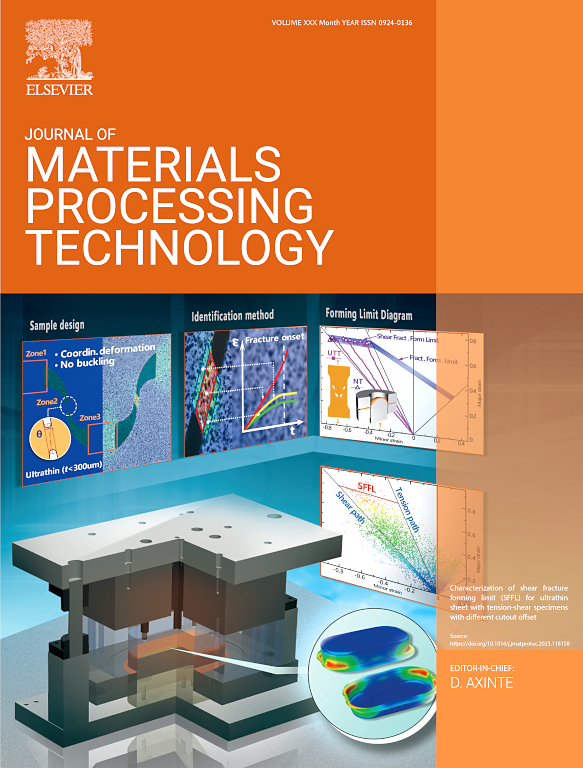Metamaterial acoustic lens-enabled noncontact real-time monitoring of mechanical properties of metal structures manufactured by additive friction stir deposition
IF 7.5
2区 材料科学
Q1 ENGINEERING, INDUSTRIAL
Journal of Materials Processing Technology
Pub Date : 2025-05-23
DOI:10.1016/j.jmatprotec.2025.118913
引用次数: 0
Abstract
Achieving high fidelity in solid-state additive manufacturing requires a precise understanding of transient material behaviors and defect formation mechanisms. This study introduces a pioneering noncontact, in-situ ultrasonic monitoring system enabled by a metamaterial acoustic lens for additive friction stir deposition (AFSD). The metamaterial lens facilitates super far-field detection at a working distance of 120 mm, ensuring thermal resilience and enhanced spatial resolution, enabling minute crack detection with subwavelength resolution (∼0.8). Numerical simulations of stress-induced variations in bulk modulus and acoustic wave propagation were validated experimentally, revealing a strong correlation between transient acoustic behaviors and material properties. Unlike conventional machine feedback or ex-situ inspections, this method uncovers subtle inconsistencies and asymmetries—such as localized thermal softening, tensile stress gradients, and feeding irregularities—during real-time deposition. Four common manufacturing flaws (over-tensile stress, lack of heat, insufficient deposition, thermal anomalies, and inconsistent feeding) were systematically analyzed, demonstrating the system's sensitivity and multifunctionality. This innovative approach bridges the gap between in-situ diagnostics and ex-situ nondestructive testing, paving the way for advanced quality control in solid-state manufacturing processes. The presented methodology is extendable to other friction-stir and solid-state metal fabrication techniques by enhancing sensitivity and integrating process control, offering transformative potential for industrial and research applications
利用超材料声透镜非接触式实时监测搅拌摩擦沉积金属结构的力学性能
在固态增材制造中实现高保真需要对瞬态材料行为和缺陷形成机制的精确理解。本研究介绍了一种开创性的非接触式原位超声监测系统,该系统由用于搅拌摩擦沉积(AFSD)的超材料声透镜实现。超材料透镜有助于在120 mm的工作距离上进行超远场检测,确保热弹性和增强的空间分辨率,实现亚波长分辨率(~ 0.8λ)的微小裂纹检测。实验验证了应力诱导的体模量变化和声波传播的数值模拟,揭示了瞬态声学行为与材料性能之间的强相关性。与传统的机器反馈或非原位检测不同,该方法可以在实时沉积过程中发现细微的不一致和不对称,例如局部热软化、拉伸应力梯度和馈送不规则。系统分析了四种常见的制造缺陷(过度拉伸应力、缺乏热量、沉积不足、热异常和进料不一致),证明了该系统的灵敏度和多功能性。这种创新的方法弥补了原位诊断和非原位无损检测之间的差距,为固态制造过程中的先进质量控制铺平了道路。通过提高灵敏度和集成过程控制,所提出的方法可扩展到其他搅拌摩擦和固态金属制造技术,为工业和研究应用提供了变革潜力
本文章由计算机程序翻译,如有差异,请以英文原文为准。
求助全文
约1分钟内获得全文
求助全文
来源期刊

Journal of Materials Processing Technology
工程技术-材料科学:综合
CiteScore
12.60
自引率
4.80%
发文量
403
审稿时长
29 days
期刊介绍:
The Journal of Materials Processing Technology covers the processing techniques used in manufacturing components from metals and other materials. The journal aims to publish full research papers of original, significant and rigorous work and so to contribute to increased production efficiency and improved component performance.
Areas of interest to the journal include:
• Casting, forming and machining
• Additive processing and joining technologies
• The evolution of material properties under the specific conditions met in manufacturing processes
• Surface engineering when it relates specifically to a manufacturing process
• Design and behavior of equipment and tools.
 求助内容:
求助内容: 应助结果提醒方式:
应助结果提醒方式:


